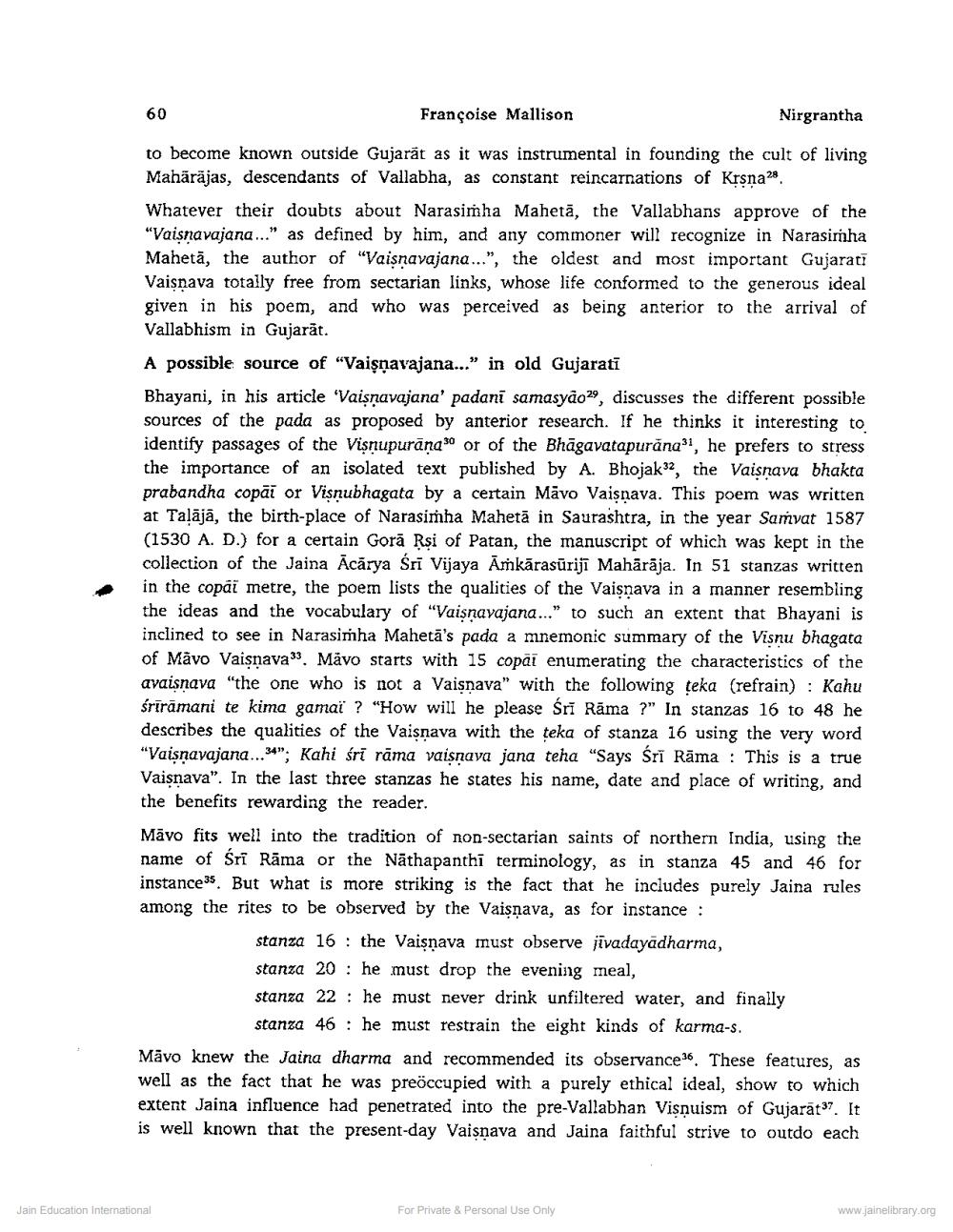Book Title: Jaina Heritage in Gujarat Author(s): Francoise Mallison Publisher: Z_Nirgrantha_1_022701.pdf and Nirgrantha_2_022702.pdf and Nirgrantha_3_022703.pdf View full book textPage 4
________________ 60 Françoise Mallison Nirgrantha to become known outside Gujarat as it was instrumental in founding the cult of living Mahārājas, descendants of Vallabha, as constant reincarnations of Krsna28. Whatever their doubts about Narasimha Mahetā, the Vallabhans approve of the "Vaisnavajang..." as defined by him, and any commoner will recognize in Narasimha Mahetā, the author of "Vaisnavajana...", the oldest and most important Gujarati Vaisnava totally free from sectarian links, whose life conformed to the generous ideal given in his poem, and who was perceived as being anterior to the arrival of Vallabhism in Gujarat. A possible source of “Vaişnavajana..." in old Gujarati Bhayani, in his article 'Vaisnavajana' padani samasyão29, discusses the different possible sources of the pada as proposed by anterior research. If he thinks it interesting to identify passages of the Visnupurānaso or of the Bhāgavatapurana", he prefers to stress the importance of an isolated text published by A. Bhojaks, the Vaisnava bhakta prabandha copai or Visnubhagata by a certain Mavo Vaisnava. This poem was written at Talājā, the birth-place of Narasimha Mahetā in Saurashtra, in the year Samvat 1587 (1530 A. D.) for a certain Gorā Rși of Patan, the manuscript of which was kept in the collection of the Jaina Ācārya Śri Vijaya Amkārasūrijī Mahārāja. In 51 stanzas written in the copai metre, the poem lists the qualities of the Vaisnava in a manner resembling the ideas and the vocabulary of “Vaisnavajana..." to such an extent that Bhayani is inclined to see in Narasimha Mahetā's pada a mnemonic summary of the Visnu bhagata of Mavo Vaisnava". Mávo starts with 15 copai enumerating the characteristics of the avaisnava "the one who is not a Vaisnava" with the following teka (refrain) : Kahu sriramani te kima gamai ? "How will he please Śrī Rāma ?" In stanzas 16 to 48 he describes the qualities of the Vaisnava with the teka of stanza 16 using the very word "Vaisnavajana...5*"; Kahi śri rāma vaisnava jana teha "Says Śrī Rāma : This is a true Vaisnava". In the last three stanzas he states his name, date and place of writing, and the benefits rewarding the reader. Māvo fits well into the tradition of non-sectarian saints of northern India, using the name of Sri Rāma or the Nāthapanthi terminology, as in stanza 45 and 46 for instances. But what is more striking is the fact that he includes purely Jaina rules among the rites to be observed by the Vaişnava, as for instance : stanza 16 : the Vaisnava must observe jīvadayadharma, stanza 20 : he must drop the evening meal, stanza 22 : he must never drink unfiltered water, and finally stanza 46 : he must restrain the eight kinds of karma-s. Māvo knew the Jaina dharma and recommended its observance 36. These features, as well as the fact that he was preöccupied with a purely ethical ideal, show to which extent Jaina influence had penetrated into the pre-Vallabhan Visnuism of Gujarat37. It is well known that the present-day Vaisnava and Jaina faithful strive to outdo each Jain Education International For Private & Personal Use Only www.jainelibrary.orgPage Navigation
1 2 3 4 5 6 7 8 9
